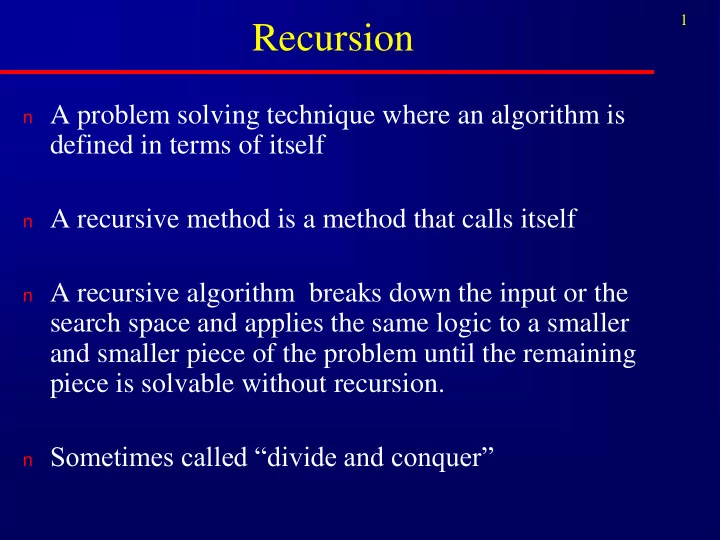

1 Recursion n A problem solving technique where an algorithm is defined in terms of itself n A recursive method is a method that calls itself n A recursive algorithm breaks down the input or the search space and applies the same logic to a smaller and smaller piece of the problem until the remaining piece is solvable without recursion. n Sometimes called “divide and conquer”
2 Recursion vs. Iteration n in general, any algorithm that is implemented using a loop can be transformed into a recursive algorithm n moving in the reverse direction is not always possible unless you maintain an additional data structure (stack) yourself.
3 Recursion Analysis n in general, recursive algorithms are more efficient l more readable (but occasionally quite the opposite!) l more “elegant” l n side effects mismanagement of memory l “over head” costs l
4 Recursion Components n Solution to the “base case” problem for what values can we solve without another recursive l call?’ n Reducing the input or the search space modify the value so it is closer to the base case l n The recursive call Where do we make the recursive call? l What do we pass into that call? l
5 How recursion works When a method calls itself – it is just as if that method is calling some other method. It is just a coincidence that the method has the same name, args and code. A recursive method call creates an identical copy of the calling method and everything else behaves as usual. Think of the method as a rectangle containing that method’s **code and data, and recursion is just a layering or tiling of those rectangles with information passing to with each call and information returning from each call as the method finishes. (** code is not actually stored in the call stack)
6 GCD Algorithm given two positive integers X and Y, where X >= Y, the GCD(X,Y) is equal to Y if X mod Y = = 0 l s else equal to the GCD(Y, X mod Y) l Algorithm terminates when the X % Y is zero. l Notice that each time the function calls it self, the 2 nd arg l gets closer to zero and must eventually reach zero.
7 What is the output of this program? public void foo( int x) ** Identify the Base { case, recursive call and if (x ==0) reduction / modification return; of the input toward the else base case. { System.out.println( x ); foo( x - 1 ); } } public static void main( String args[]) { foo( 7 ); }
8 What is the output of this program? public int foo( int x) ** Identify the Base case, { recursive call and if (x ==0) reduction / modification of return 0; the input toward the base else case. return x + foo(x-1); } public static void main( String args[]) { System.out.println( foo(7) ); }
9 What is the output of this program? public int foo( int x, int y) { if (x == 0) return y; else return foo( x-1, y+1 ); } public static void main( String args[] ) { System.out.println( foo( 3, 4 ) ); } ** Identify the Base case, recursive call and reduction or modification of the input toward the base case.
10 What is the output of this program? public int foo( int x, int y ) { if (x == 0) return y; else return foo( x-1, y+x ); } public static void main( String args[]) { System.out.println( foo( 3, 4 ) ); }
11 Now.. You help me write this n Write a recursive function that accepts an int and prints that integer out in reverse on 1 line n What is the base case ? n How do I reduce the input toward base case ? n What do I pass to the recursive call ?
12 One more try! n Write a recursive function that accepts a string and prints that string out in reverse on 1 line. n What is the base case ? n How do I reduce the input toward base case ? n What do I pass to the recursive call ?
13 Other Examples ... n Bad examples (but for illustration/treaching) factorial l exponential l Fibonacci numbers l power l
14 Other Examples ... n Good examples Towers of Hanoi l GCD l Eight Queens l Binary Search Trees l Maze traversal l Backtracking (i.e recovery from dead ends) l
15 Tail Recursion optimization n Recursion can use up a lot of memory very quickly! n The compiler can generate assembly code that is iterative but guaranteed to compute the exact same operation as the recursive source code. n It only works if the very last statement in your method is the recursive call. This is tail recursion. n Java does not tail optimize recursive code.
Recommend
More recommend